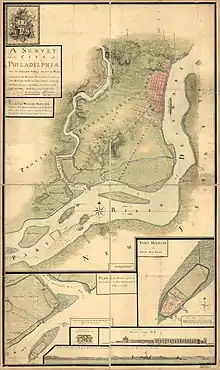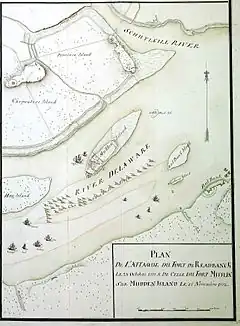| Fort Mercer | |
|---|---|
| National Park, New Jersey | |
 Monument in Fort Mercer, dedicated 1906 | |
 Fort Mercer  Fort Mercer  Fort Mercer | |
| Type | Earthwork |
| Site history | |
| Built | 1777 |
| Built by |
|
| In use | 1777–1781 |
| Materials | earth, logs |
Red Bank Battlefield | |
| Location | 100 Hessian Ave., National Park, NJ 08063 |
| NRHP reference No. | 72000796[1] |
| NJRHP No. | 1405[2] |
| Significant dates | |
| Added to NRHP | October 31, 1972[1] |
| Designated NHL | November 28, 1972[3] |
| Designated NJRHP | August 16, 1979 |
| Battles/wars | American Revolutionary War |
| Garrison information | |
| Past commanders | Christopher Greene |
Fort Mercer was an earthen fort on the Delaware River on its New Jersey shore constructed by the Continental Army during the American Revolutionary War. Built by Polish engineer Thaddeus Kosciuszko under the command of George Washington, Fort Mercer was built in 1777 to block the approach to Philadelphia, Pennsylvania in concert with Fort Mifflin on the Pennsylvania side.
Fort Mercer was located in an area called Red Bank in what is now the borough of National Park in Gloucester County, New Jersey. The fort was named in honor of Brigadier General Hugh Mercer who died earlier that year at the Battle of Princeton. The fort's site is now part of Red Bank Battlefield Historical Park, which includes a monument and museum. Several cannons attributed to British warships lost supporting the attack on the fort, and others found buried at the fort itself, are in the park.[4]
Background

Fort Mercer was built and Fort Mifflin was rebuilt and garrisoned to protect a line of chevaux de frise obstacles across the Delaware River. Fort Billingsport was built downriver to protect another line of these obstacles. Fort Mercer had earthen walls with a surrounding ditch, topped with a log palisade. The fort was about 320 yards (290 m) long and 50 yards (46 m) wide and mounted 14 cannons, with bastions on the landward corners. A separate outer redoubt was located north of the fort, but this was not garrisoned. The fort could accommodate a garrison of 1,500 men, but only 600 were available, mostly Rhode Island troops of the Continental Army commanded by Colonel Christopher Greene, also a Rhode Islander. French officer Thomas Duplessis made the fort more defensible by the small garrison by having a wall built inside the river side of the fort.[5]
On October 22, 1777, in the Battle of Red Bank, an attack by 900 Hessian troops under British Major General William Howe, then occupying Philadelphia, was repelled by Fort Mifflin's defenders with heavy losses on the Hessian side, over 500 casualties including the death of their commander, Colonel Carl Emil Kurt von Donop. The defenders suffered only 40 casualties.[4] Galleys of the Continental and Pennsylvania Navies under Commodore John Hazelwood provided supporting fire. Six British warships under the command of Admiral Francis Reynolds were also involved, two of which ran aground while avoiding the chevaux de frise and were soon destroyed by fire during the battle. Fort Mifflin and the Pennsylvania Navy engaged the stranded ships the next morning, with cannons and fire rafts, respectively. HMS Augusta of 64 guns caught fire and within an hour the fire reached the magazine and the ship exploded, though the loss was attributed to accidental ignition by the British. One account states a British Marine accidentally fired his musket into a hammock, with the fire resulting from subsequent smoldering. HMS Merlin was also lost. After the later loss of Fort Mifflin, Fort Mercer was abandoned when Lord Charles Cornwallis landed 2,000 British troops nearby on November 18, 1777. As British artillery breached the walls, the defenders of Fort Mercer blew up their magazine before abandoning the fort.[6][7][8]
The British abandoned Fort Mercer as they evacuated Philadelphia on June 18, 1778. The Patriots re-occupied the site and rebuilt the fort, manning it until 1781 when the fighting moved to Yorktown, Virginia.[9][5]
Gallery
- During the Philadelphia Campaign the British had several maps drafted of the Delaware River, Fort's Mifflin and Mercer and the greater Philadelphia area.





See also
References
- 1 2 "National Register Information System". National Register of Historic Places. National Park Service. July 9, 2010.
- ↑ "New Jersey and National Registers of Historic Places - Gloucester County" (PDF). New Jersey Department of Environmental Protection - Historic Preservation Office. April 1, 2010. p. 6. Archived from the original (PDF) on August 18, 2011. Retrieved September 28, 2010.
- ↑ "Red Bank Battlefield". National Historic Landmark summary listing. National Park Service. June 23, 2008. Archived from the original on February 25, 2009.
- 1 2 "Fort Mercer". RevolutionaryWarNewJersey.com.
- 1 2 "Fort Mercer". FortWiki.com.
- ↑ "Survey of Historic Sites and Buildings". National Park Service. Retrieved September 24, 2007.
- ↑ Roberts, Robert B. (1988). Encyclopedia of Historic Forts: The Military, Pioneer, and Trading Posts of the United States. New York: Macmillan. pp. 511–512. ISBN 0-02-926880-X.
- ↑ "The story of the battle of Red Bank". friendsofredbank. Retrieved December 12, 2018.
- ↑ "Fort Mercer". American Forts Network.
External links
 Media related to Fort Mercer (New Jersey) at Wikimedia Commons
Media related to Fort Mercer (New Jersey) at Wikimedia Commons- Forts and Fortifications at PhiladelphiaEncyclopedia.org
